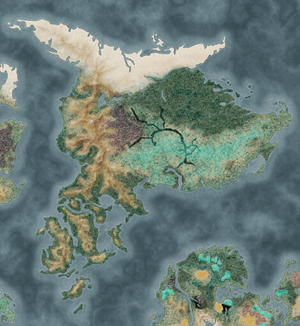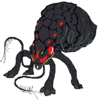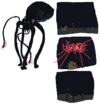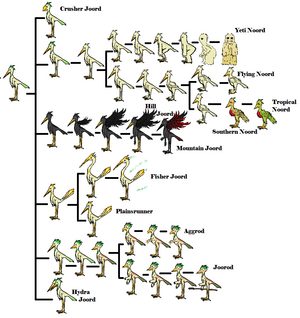Primordial Evolution Game/East Continent
 This page is needs images. Help plz. This page is needs images. Help plz. |
This article details the events of the East Continent Evolution stage in the Primordial Evolution Game.

Progenitors
Boomer: A derivative of the Hopping Flouz. Boomers are blind, pig-sized herbivores. Their large abdomens are filled with methane, which they ignight upon serious injury or death as a deterrent to predators.
Higitain: An offshoot of early Land Slizers. Due to isolation and a small population, they've lost a small bit of their agression and their adhesive acid-spray.
Govnik: Ambush predators which are descended from Stalcks.
Joord: Descendants of Bords which landed in the far east. They've become tall and slender with a long beak for wading into shallow waters in order to catch fish.
Ngung: A fluzpuff derivative. They live off of a varied diet of carrion, detris, dung, and sap.
Ribboner: This speedy flier is an offshoot of Flatworems. It feeds on small insects.
Dahon: Colonies of microscopic jellyfish acting as if they were a single organism. They feed on algea and small organisms.
Keerb: Relative of Krubs, Keerbs are amphibious arthropods which feed on riverside plants and detris.
Glowing Ramel: A descendant of Ramel Magnificus. It has luminescent compounds in its exoskeleton.
Ramel Stalker: The Ramel Stalker is a bipedal glundiform with an internalized skeleton. It hunts using its bladed snout.
Azrach: A leafless tree descended from Yantars with photosynthesetic bark. They asexually produce fruit which are eaten by many herbivores.
Tapascu: This Yantar derived plant protects itself from herbivores with large spikes around its base. It releases spores to reproduce.
Vindra: This blue plant is a species of Hrass which has broad leaves and tuberous roots.
Boomer Evolution

Eyespot Boomer

Eyespot Boomer
Status: Extinct
progenitor: Boomer
-> Crawling Boomer
-> Coastal Boomer
-> Walking Boomer
Boomers developed two large light-sensitive patches on their faces.
Crawling Boomer

Crawling Boomer
Status: Extinct
progenitor: Boomer
-> Climbing Boomer
The crawling boomers developed stronger feet, with their fingers developing into almost claw-like digits. This allowed them to dig in deeper to the ground and gain purchase on a larger variety of terrain, as well as cling to surfaces better.
Climbing Boomer

Climbing Boomer
Status: Extant
progenitor: Crawling Boomer
The Climbing Boomers have specialized in living in the vast canopies of the azrach forests that cover the eastern coastline and swamps. Their tentacles are longer and stronger, and they move through the canopy by swinging themselves from one branch to another. Over time, they gained elaborate luminescent displays and sticky surfaces on their palms. They mostly eat the fruits and bark of the azrach trees.
Coastal Boomer

Coastal Boomer
Status: Extant
progenitor: Boomer
The front legs of boomers living on the southern coast became webbed in order to swim back to shore whenever they were swept out to sea. They also developed transparent eyelids.
Walking Boomer

Walking Boomer
Status: Extinct
progenitor: Eyespot Boomer
-> Mountain Boomer
-> Crag Boomer
-> Plains Boomer
-> Frilla Boomer
-> Tundra Boomer
-> Swamp Boomer
Over time, the boomers living near the plains developed stronger tentacles, which allow them to walk, instead of simply crawling on the ground. These boomers live in small herds, using the noxious gases their former slime glands adapted to excrete for common protection.
Mountain Boomer
Mountain Boomer
Status: Extinct
progenitor: Walking Boomer
-> Cave Boomer
-> Green Boomer
Due to flooding for parts of the year, some boomers began to seek higher ground. Eventually they became the mountain boomers, who have hard clawed hoof like feet which help them to move in the rockier environment.
Volcanic activity caused a split in the mountain boomer species. Their population suffered heavily from the eruptions, and most of the survivors had to migrate to south, away from the most active volcanoes. These mountain hoppas were few and far between, they live in small herds that wandered the southern mountains in search of food.
Cave Boomer

Cave Boomer
Status: Extant
progenitor: Mountain Boomer
The Mountain Boomers which stayed in the northern mountains sought safety in caves and nooks that shielded them against the volcanic activity. Over time, these cave boomers became reclusive species, usually only living by themselves or in small family groups. Their skin became thicker and developed hard scale like plates that protected the creatures against the irritating ash that was everywhere. The plant life in the mountains was too scarce to get rid of the nutrient rich material very fast. Without their now thicker skin, the ash would smear and cause infections in the sensitive skin of the boomers.
Green Boomer

Green Boomer
Status: Extant
progenitor: Mountain Boomer
Crag Boomer

Crag Boomer
Status: Extinct
progenitor: Walking Boomer
-> Red Boomer
Just like the mountain Boomers, these too migrated to the mountains to escape the floods. Rather than hoofed feet, they developed stronger digits to grip and climb the uneasy surfaces.
Red Boomer

Red Boomer
Status: Unknown
progenitor: Boomer
-> Bagr
-> Will'o'wisp Boomer
Red Boomers a carnivorous species. They lost their beak in favor of a fanged maw. Their skin is covered in armored plates, which most likely formed as protection from falling rock in the geologically active region in which they live.
Bagr

Bagr
Status: Extant
progenitor: Red Boomer
Will'o'wisp Boomer

Will'o'wisp Boomer
Status: Extant
progenitor: Red Boomer
Running Boomer

Running Boomer
Status: Extinct
progenitor: Walking Boomer
-> Long-Legged Boomer
Wild fires were devastating for boomers, which are incredibly vulnerable to fire, as the gases their bodies contain are quite flammable. The only ones who survived these fires were the ones with longest and the fastest legs. Over time, these fast boomers became the dominant boomer variety on the plains.
Gotta go fast!
Long-Legged Boomer

Long-Legged Boomer
Status: Extant
progenitor: Running Boomer
-> Stilt Boomer
>implying fires can touch me.
Stilt Boomer

Stilt Boomer
Status: Extant
progenitor: Long-Legged Boomer
>implying fires can touch me either.
Jungle Boomers

Jungle Boomer
Status: Extant
progenitor: Running Boomer
These tall, dexterous boomers feed on vegetation toward the canopy of the jungles in the southwest.
Frilla Boomer

Frilla Boomer
Status: Unknown
progenitor: Walking Boomer
-> Sap Boomer
-> Gliding Boomer
In order to escape seasonal floods, these Boomers began to climb up the surfaces of the massive Frilla trees. They developed gecko like paws which allowed them to do so with ease. They also became much smaller.
Sap Boomer

Sap Boomer
Status: Extant
progenitor: Boomer
The sap boomer has a strong, chisel-like beak. They use it to break off layers of Frilla bark and reach the layer of phloem so that they may drink the sap carried within. Their skin has taken on a pigment similar to that of the bark, so they may feed uninterrupted by predators.
Gliding Boomer

Gliding Boomer
Status: Extant
progenitor: Frilla Boomer
Swamp Boomer

Swamp Boomer
Status: Extant
progenitor: Walking Boomer
-> Predatory Boomer
The legs of Walking Boomers which moved into the swamps became longer to traverse the watery terrain. Their skin also became darker to blend in with the environment.
As the the terrain of the swamps became more difficult from the dense Azrach growth, the boomers developed claws on their toes in order to better grip to the roots and trunks of the trees which they walked along.
Predatory Boomer
[[Image:null.png|thumb|upright|left|top|100px|
Predatory Boomer
Status: Extant
In the harsh struggle of survival in the dark and damp central marshes, a new predatory splinter species of the swamp boomers emerges. These boomers have adapted to the low light conditions of the central marshes, by developing Infrared sensitive eyes, which allow them to better track suitable prey. Unfortunately, these new eyes are vulnerable to direct sunlight, which confines these species to the perpertual darkness of the central marsh, and forces them to move in the other parts of the great azrach forest during the night.
These carnivorous boomers hunt smaller critters, their swamp boomer bretheren, govinks and keerbs. Their strong and sharp fangs allow them to make short work out of their prey. The predatory boomers hunt by outmanouvering their prey, using the speed and agility that all the swamp boomers posses to get the kill.
Tundra Boomer

Tundra Boomer
Status: Extinct
progenitor: Walking Boomer
-> Arctic Boomer
The tundra boomers are bigger and stockier than their cousins, and they move in great herds for mutual protection. They have lost their gas discharge defense, as their bodies need to focus on keeping the creature warm. They've begun to develop an organ attached to their lungs and float sacs which burns small amounts of their internal methane supply for heat. The sensory hairs of their toes have also started to spread to the rest of their legs, as they help in retaining heat.
The tundra boomers mostly feed on tubers and other plant material found in the north during the summer. They migrate south during the winter, as even they can't stand the cold arctic winter, despite their adaptations.
They spend the winter on the southern side of the riverside plains of this continent. When summer comes, the swim across the river and return to the north and begin once again to feast on the vindra tubers of the tundra. The walking boomers give birth to more developed young, who don't float away from the herd, like they do in most hoppa an boomer species. They usually breed during spring, and give birth during summer, so that the young can quickly get fat on the abundant plant life of the tundra.
Arctic Boomer

Arctic Boomer
Status:
progenitor: Tundra Boomer
-> Wooly Boomer
Volcanic eruptions resulted in disrupting the migration cycle of the tundra boomers. They could not cross the muddy river, and thus they were forced to endure the cold winter of the north. Many of them died, and the ones who survived were hairiest of them all. Within relatively few generations, the boomers became extremely hairy. These hairs grow before winter, and they trap the internal heat of the boomer very efficiently, allowing these creatures to survive the harsh arctic winter. They no longer migrate back to the south. They do come closer to the river during the winter, but they do not cross it anymore.
Wooly Boomer

Wooly Boomer
Status: Extant
progenitor: Arctic Boomer
Wooly Boomers are massive creatures which live in the cold north year-round, traveling in small herds. Their thick, shaggy fur is very effective in holding in the heat which the creatures produce from their methane burning. The diet of these boomers is made up of grasses and roots which they dig up using the tusks to either side of their beak. One major distinction between Wooly Boomers and all other species is that these have skeleton make entirely of actual bone rather than mostly cartilage.
Higitain Evolution

Frilla Forest Higitain
These Higitains are vicious predators which grab onto prey with their large fangs and mandibles and rip it apart with the tiny clawed mouthparts. Due to a long period of frequent floods, they gained clawed feet in order to scale the massive Frilla trees.
Plains Higitain
Plains Higitains have shear-like mandibles which they slice their victims up with. On theri front, they have two scythe-like limbs which are actually used to crack open the shells of other creatures.
Northern Hitigain
A simple predator that hibernates for the winter.
Swamp Higitain
Govnik Evolution

Joord Evolution

Smart Joord
Aggrod
Joorod
Plains Joord
Fisher Joord
Noord
Stalker Noord
Flying Noord
Hill Joord
Mountain Joord
Crusher Joord
Hydra Joord
Ngung Evolution

Ribboner Evolution

Dahon Evolution

Balloon Dahon
Frilla Dahon
Ocean Dahon
Bladdered Dahon
Upright Dahon
Keerb Evolution
